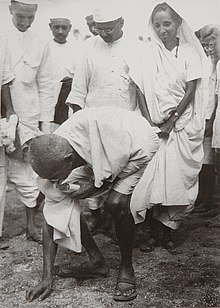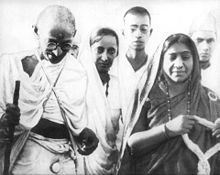Mithuben Petit


Mithuben Hormusji Petit (11 April 1892 – 16 July 1973) was one of the pioneer Indian independence female activists[1][2] who participated in Mahatma Gandhi's Dandi March.[3][4] She became a recipient of India’s fourth highest-civilian honour, Padma Shri in 1961, for her social work.
Family and background
Born on 11 April 1892 into an affluent
Mithuben Petit studied at Convent of Jesus and Mary, Colaba.[7] Her activism was met with challenges by the Petit family, who urged her to renounce her activism or risk disinheritance, to which she refused and responded: "It is your business to sit with the government and mine to remain with the nation.".[8]
Career
Indian independence movement
The young Petit Baroness was influenced by her aunt, Jaiji Jehangir Petit, who was a follower of Mahatma Gandhi and was the Secretary of the Rashtriya Stree Sabha, a women's movement founded on Gandhian ideals.[9] She was active in the relief work during the floods of Gujarat in 1927, along with Ratanbahen Mehta and Bhaktiba Desai. During Bardoli Satyagraha in 1928, she moved from village to village to create awareness among the women. She took part in Borsad Satyagraha in 1929 and stayed at the camp.
Petit, along with
Social work
Petit set up an
Death
She died on 16 July 1973, at Surat.[6]
Recognition
Petit received the Padma Shri in 1961 for her social work.[16][17]
References
- ^ ISBN 9788177640700.
- ISBN 978-81-237-3766-9.
- ^ "Mahatma Gandhi, Sarojini Naidu and Mithuben Petit". gandhiheritageportal.org. Retrieved 2 July 2017.
- ISBN 9788178351742.
- ^ Marzban J. Giara (2000). Parsi statues. Marzban J. Giara.
- ^ a b Gawalkar, Rohini (28 September 2013). "पद्मश्री 'दीनभगिनी'". Loksatta (in Marathi). Archived from the original on 28 July 2017. Retrieved 28 July 2017.
- ^ "Unsung Heroes Detail: Paying tribute to India's freedom fighters". 4 December 2023. Retrieved 4 December 2023.
- ^ Meher Marfatia (19 August 2007). "From Silk to Satyagraha" (PDF). Sunday Times of India. Archived from the original (PDF) on 23 February 2022. Retrieved 2 May 2021.
- ISBN 9789351502869.
- ^ a b Gandhi, Gopalkrishna (5 April 2010). "The Great Dandi March – eighty years after". thehindu.com. Retrieved 2 July 2017.
- ]
- ^ "anti-liquor movement". mkgandhi.org. Retrieved 3 July 2017.
- ^ "Trustees". Kasturbasevashram.org. Archived from the original on 3 January 2018. Retrieved 20 July 2017.
- ^ "Kasturba Sevashram". kasturbasevashram.org. Archived from the original on 12 June 2018. Retrieved 20 July 2017.
- PMID 29527053.
- ^ "Padma Shri in 1965 for social work". padmaawards.gov.in. Archived from the original on 28 July 2017. Retrieved 2 July 2017.
- ^ "Mithuben Petit Padma Shri" (PDF). pib.nic.in/archive/docs. Archived from the original (PDF) on 28 July 2017. Retrieved 6 July 2017.
